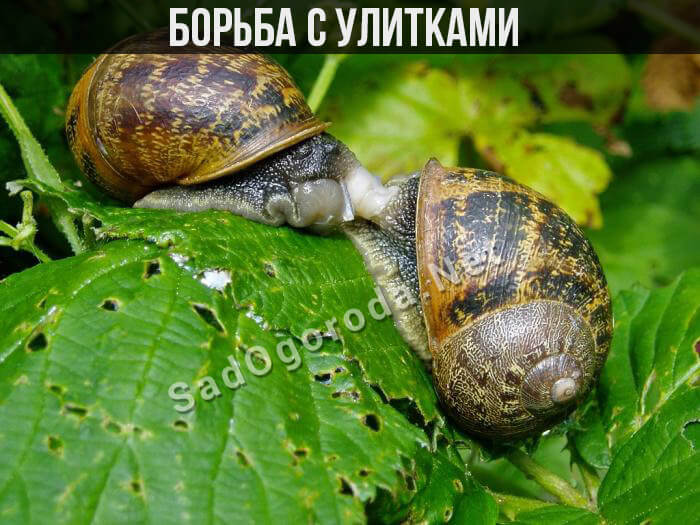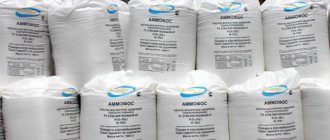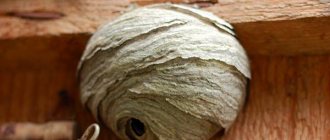If you ignore the "enemy"

Snail - a pest for the gardener
To begin with, we emphasize: on the personal plot, you can meet both the snail itself and its closest relative, the slug. They are similar in many ways, only slugs are smaller in size and do not have a protective shell. Although, it is true, it is much less common, and the transitional subspecies is a semi-slug, which partially retained its protective shell. In principle, it does not matter which mollusk climbed into your site, in any case, you should expect trouble from it.
What will happen if no measures are taken against the snails? The harmful actions of the mollusk are as follows:
- the snail can eat young plants whole - at the root;
- eaten leaves on plants slow down the natural process of photosynthesis and the plant stops developing;
- the pest loves inflorescences, which is fraught, in principle, with obtaining at least some kind of harvest;
- the pest leaves unattractive paths on the fruits, eating the top shell and making them unsuitable for storage;
- snails - carriers of fungal spores and helminths that parasitize animals;
- leaving mucus on the fruits, mollusks provoke their rapid decay.
Important! According to scientists, the snail menu consists of more than 150 species of plants. So in the garden in any region of Russia for them there will be crops "to their liking." Hence, it is wrong to ignore these uninvited guests.
Natural methods
Gardeners prefer to use natural methods of dealing with pesky gastropods. They are also used for preventive purposes.
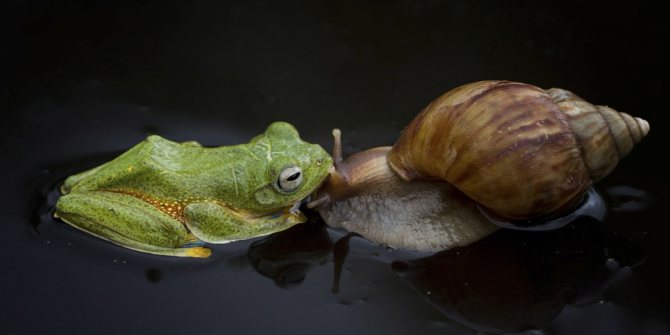

Molluscs are a favorite delicacy of hedgehogs, toads, frogs, ground beetles, and birds. It is recommended to create conditions that attract these animals to the summer cottage. For this it is enough:
- build and hang birdhouses;
- leave treats for hedgehogs in the garden overnight;
- spread mulch from cut weeds in the aisle.
Snails will not settle on the site if they are deprived of comfortable living conditions:
- remove boards;
- drain wetlands;
- thin out the plantings;
- remove mulch from the garden;
- plow the beds deeply in the spring.
Get rid of snails in the area by chemical means
Option 1
Common table bite is a substance that is very effective against snails. A solution is prepared at the rate of 50 ml of a bite in a 10-liter bucket of water. This solution must be poured into those places where traditionally snails, which are active at night, hide for the time of day. In this case, special attention should be paid to the boards along the garden paths, stones on the site, the entrance porch of the house, the summer shower, the area around the bathhouse, heaps of grass or branches.


The snail is omnivorous and gluttonous
Option # 2
Chemicals specially developed against snails and slugs:
- "Storm";
- "Meta".
This is, due to a small discrepancy in the component composition, identical preparations created on the basis of a very potent poison - metaldehyte. It is supplied to the consumer in the form of blue granules in packages of 15 g. One such dose is enough for 5 m2 of land. When using them, it is necessary to ensure inaccessibility for pets. All berries and vegetables must be washed several times before use. Gardeners say that the mollusk, upon contact with the drug, becomes like an immobile worm and dies.It is imperative to poison the snails in the garden with granules with gloves.
Option # 3
Powdered superphosphate is an effective remedy against shellfish in the garden. It must be scattered over the area at the rate of 200 g per 10 m2.
Fourth way: coffee
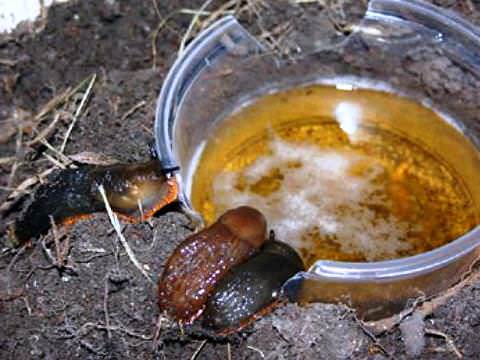

The aroma of coffee repels shellfish, so you can use this drink to spray plants that can become food for snails. For processing crops, you should brew very strong coffee or make it from instant coffee. Then cool and use for spraying cabbage, cucumbers, strawberries and other crops that shellfish like so much. In this case, strong coffee should be sprayed not only on the plants, but also on the area around them. Snails do not like the aroma of coffee, so they leave the sprayed area. It is recommended to spray after every rain or watering the beds.
Destroy snails in the garden: our readers share tips
Salt
Irina Sarukhanova, Ivanovo region
The harm from snails in the garden is terrible. When we bought the dacha, in the first year I practically lost the entire cabbage crop. Since spring I have met snails here and there, but did not pay attention. As it turned out, in vain. Now, I am very careful. And every morning I start by going around the beds, with salt at hand. I noticed a clam - sprinkled it. It melts instantly, like bacon in a frying pan. I don’t want to use chemistry, I don’t trust any broths. And I destroy the snail physically - so far there are no complaints about the effectiveness of the method.
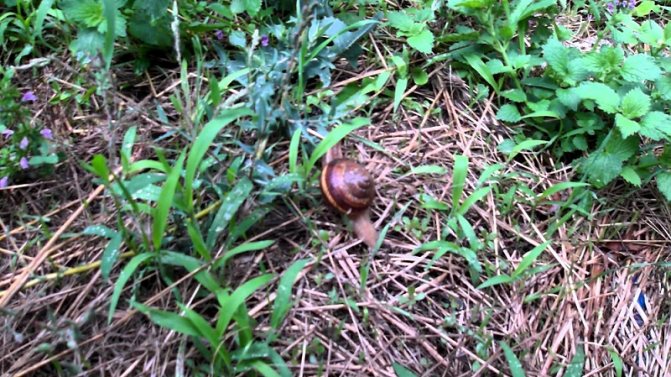

The snail loves piles
Superphosphate
Ivan Ivanovich, Kaluga region, Ostrozhki village
I make traps. Any improvised means are used - pieces of slate, planks, stones, bricks, heaps of weeds, etc. At night, the pest will surely climb into them. In the morning I go around all these "hot" places and collect shellfish in a bucket. And the edges of the beds, in order to keep out the pest, I sprinkle with powdered superphosphate. Only the width of the strip is not less than 10 centimeters. Even if a snail crawls, it will end. Moreover, it is important that superphosphate is a valuable fertilizer for the soil. After rains, the protection needs to be renewed. Nothing complicated, but the effect is great.
Ash
Valentina Nikolaevna, Krasnodar region
My weapon against snails and slugs is regular wood ash. I sift it through a sieve and sprinkle the beds with this powder. It is not necessary, I think, to explain what a useful plant food it is. And for snails, it is poison, because there is alkali in the ash. At the first contact, they secrete mucus, as they say, shed, and upon repeated contact, they die.
Michael. O., Ivanovo
Beer
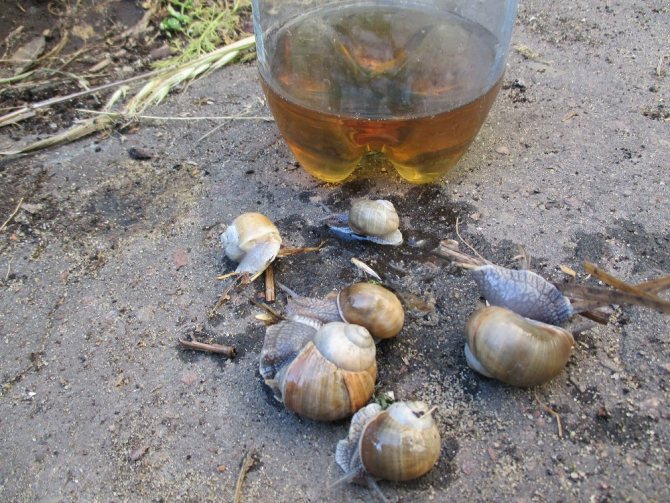

Snail - beer will ruin
Snails love beer - I didn't find out, but found it on the forum on the Internet. But, in practice, now I use traps from cut bottles, cans from canned olives or other containers. All over the garden they stand with me with beer - they need to be changed in two days for the third. Almost every morning I get snails out of there in decent batches. And recently I was told that you just need to sprinkle the vegetables with a coffee drink and the snail will leave the site voluntarily.
Coniferous needles
Alina Ponomareva, Moscow region
The snail is afraid of spruce and pine needles. We just cover the paths between the beds with this material. And the mollusk does not give us any problems. I am especially happy for the strawberries, otherwise they lost up to a third of the harvest.
Feeding with droppings
Eleanor Belaya, Voronezh
My neighbors in the country have more problems with these molluscs - both snails and slugs. And I don't have them at all. There is an ordinary wooden picket fence between our areas, so there are no obstacles. We decided for a long time, consulted what was the matter and came to the conclusion that the reason is that I have been feeding the plants with chicken droppings for a long time from year to year. Looks like the snail doesn't like this.
Another recommendation! Scientists who study these representatives of the fauna claim that in the wild, the snail bypasses the fern. Logically, the tincture of this plant will be a prophylactic agent in the country-house garden.
How to prevent snails from emerging?
In the diet of snails, not only fresh juicy leaves are present. Molluscs still feed on dead plants, and therefore bring not only harm, but also benefit to gardeners.
Although most often such benefits are hardly noticeable, because in these harmless-looking animals, scientists have counted more than 14 thousand teeth, with the help of which they grind everything juicy that grows in their path.
That is why people have to look for ways to destroy gluttonous individuals in the garden and in the garden.
It is difficult to deal with the invasion of such pests. To remove them, it is recommended to use mechanical, chemical and folk methods.
But most of all, those gardeners who have learned to prevent the appearance of snails in the garden and in the vegetable garden were lucky.
Photo:


Experienced summer residents recommend eliminating favorable conditions for shellfish. First of all, you need to get rid of the shelters in the garden and in the garden in which snails can live.
Most often these are mowed weeds, tall grass on the borders of the vegetable garden or in the garden, heaps of stones.
Sometimes the gardener does not even suspect why it is so difficult for him to get rid of the snails, but this factor is explained by the dense planting of plants and the untimely removal of the lower leaves of the seedlings, under which the mollusks hide.
It is necessary to fight pests in the garden by regularly weeding the soil, which will not allow them to hide in the cracks of the earth.
It will be possible to get rid of snails forever if you do not leave them a chance of survival in the cold season. For this purpose, it is recommended, after harvesting, to remove all plant residues from the garden in which they could hide and eat.
Although the snail is a natural orderly, it still harms the crop. Of course, you need to fight it, but taking into account the fact that everything is interconnected in nature, and each inhabitant of the fauna has its own role, and the snail is no exception.
Therefore, wanting to get rid of mollusks that are harmful to the crop, you need to understand that if you completely destroy them on the site, then there will be no one to heal the ecological system of the garden.
Gardening culture
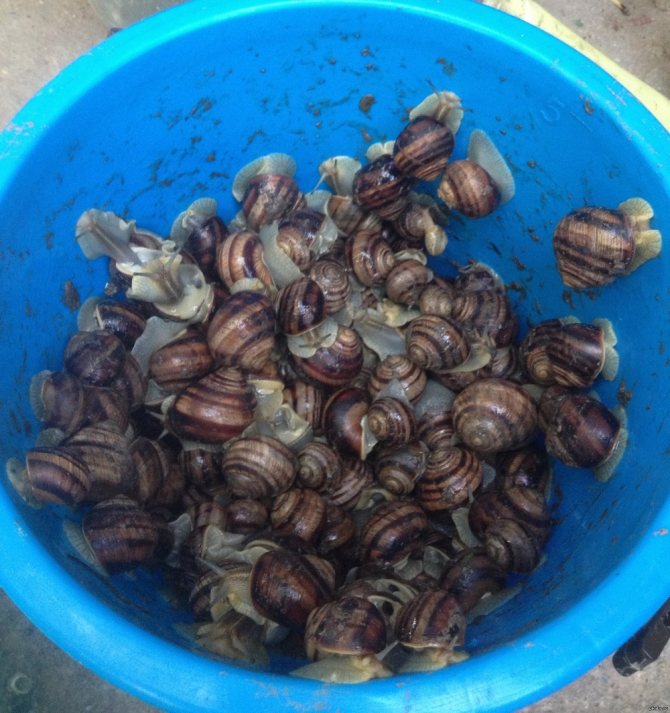

Fermented compote can be poured into the bait
- It has been known since ancient times that the soil needs to be dug up for the winter. This is done, among other things, to destroy multiple garden pests that go deep into the ground for wintering.
- Weed control and regular plowing are activities in the same direction. They allow you to kill eggs and larvae, which in the warm season multiply in the upper soil layer or on weeds.
- There should be no piles on the beds themselves and next to them. Even the grass is taken out during weeding so that the snails do not create shelters with their own hands.
- When planting, it is necessary to observe the normal density of the arrangement of crops. If they are placed too densely, then a favorable environment will be created for the life of snails.
We hope you managed to read our article before the start of the garden season, and on the garden plot you will be able to timely take care that snails do not spoil your joy from the healthy harvest.
Check out articles on similar topics
- Getting rid of slugs in the garden
- Rapeseed beetle and control measures
- Mouse shrew or shrew
- How to get rid of shrews
Comments (1)
leave a comment
Chemical methods
Unfortunately, it is not always possible to get rid of snails with the help of preventive measures. It is quite difficult to collect all the pests with your hands and take them far outside the garden, if only for the reason that they are successfully camouflaged in the daytime.At night in continuous darkness it is impossible to collect them without lighting.
In such cases, the problem with snail invasions can be eliminated using the proposed chemical technologies that involve the use of special chemicals:
- "Thunder";
- "Meta";
- "Ulicid".
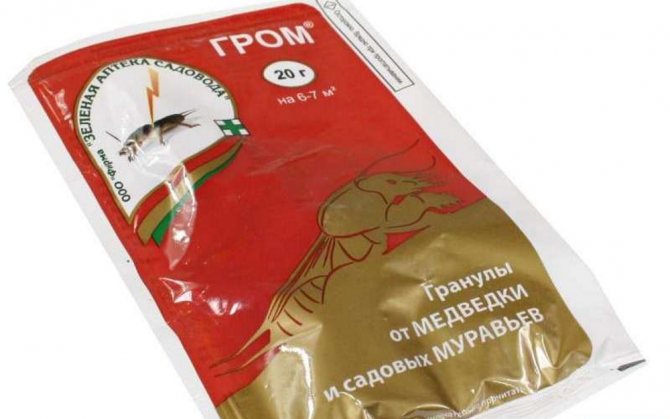

All of these drugs are based on metaldehyde. When this substance is absorbed, the body of the gastropod mollusk begins to shrink, rapidly losing moisture. As a result, the snail dies from lack of moisture.
Some summer residents categorically refuse to use such a chemical method. Their decision is argued by the fact that metaldehyde is dangerous not only for slugs, but also for humans and animals.
When using the drug in rainy weather, the result will be zero, since snails will be able to compensate for the lack of moisture in the body due to rainwater.
Summer residents advice
If you follow these instructions, you can pretty well save the beds from the "raids" of snails, and therefore we recommend adding this page to your bookmarks and advising your friends and acquaintances as needed:
- Even when planting plants, in spring, lay pieces of plywood or boards in the corners of the beds, which will create a refuge for the snails. Help the molluscs find their place under them, for example, by placing stops under the plywood so that a kind of void is created below. Then, after sprouting, check your traps every week and get snails from under them, which will sit in place all day and only crawl out in the evening to feed. Slugs, which are also pests of the garden, will also gather here;
- Around the same time you plant your plants in the spring, take care to protect your garden as much as possible. Plant protective plants around to keep the pest out of the green shoots. So you will save a significant part of the crop from destruction;
- Routine maintenance of garden beds and flower beds already gives you the opportunity to effectively control pests. Think about how good wood ash is for the soil, and just sprinkle it on the area. Naturally, not constantly, but periodically, thereby creating difficulties for the movement of pests and enriching the soil with useful substances;
- About once a month, carry out preventive spraying of plants with complex preparations that affect several types of pests at once.
Just a few points, and the standard biological snail protection works. If this does not help, we advise you to resort to the use of special chemicals that will help to put things in order at the site.
Fighting shellfish in your own dacha is not as difficult as at first glance. This is not a spider mite, which is difficult to remove from the greenhouse, and not even the Colorado potato beetle, which is full of potatoes every year. Snails are a serious greenery eater, but you can destroy it, especially if you are already prepared for this confrontation.
The benefits of snails
Despite the fact that snails cause significant harm to garden plants, a small number of them bring some benefits. They play a role in the ecosystem of the garden. Snails act as garden orderlies, as they are able to process dead or damaged plant parts. This is the reason for the application of humane measures to combat them: preventing snails from accessing weak or young plants, reducing the number of mollusks by manually collecting them or planting plants in the area that they do not like very much and avoid - these are petunias, watersheds, lilies of the valley, arums, spurge, lavender, gladioli, marigolds, garlic, nasturtium and all bindweed.
In addition, snails are increasingly being used in alternative medicine for the treatment of skin diseases, anti-aging procedures and getting rid of stretch marks and scars. The healing properties of snail mucus have been known since ancient times.Mucin and complex proteins that are in mucus are able to heal wounds, activate fibroblasts and stimulate the production of collagen, elastin and hyaluronic acid. Regular use of snails significantly improves skin condition, smoothes wrinkles and lightens age spots. Slime can be obtained from snails by placing them in a clean container and scaring them with a stick. From fear, they begin to actively secrete mucus, which accumulates on the walls of the container. Then the snails are removed, and the mucus is scraped off and added to creams or masks. However, the use of live snails by the contact method leads to a faster and more tangible result, since the artificially collected mucus quickly loses its quality.
Agrophysical methods and traps of slugs and snails
First of all, this method includes deep plowing of the land in early spring and autumn, as well as timely pulling out of all weeds with their subsequent burning. You can also make the following traps or obstacles:
1. Plants. Snails cannot tolerate sharp and bitter plants. Therefore, you can plant onions, sage, wormwood or garlic between the rows. This will not scare off the snails by 100%, but their number will noticeably decrease. The same effect can be achieved by planting rosemary, parsley, bay leaves, or other herbs.


Agrophysical methods of dealing with slugs and snails
2. Sprinkling. Since the abdomen of slugs is very delicate, it is possible to make the simplest, but insurmountable obstacles for snails from thorny or sharp substances. This product should be scattered abundantly between the beds and along the paths. Also, do not forget to update the barrier every 2-3. Suitable:
- finely ground eggshell;
- ash or ash from cigarettes;
- fine sand;
- salt;
- coffee;
- thoroughly ground pepper;
- needles of coniferous trees.
3. Beer. Snails love him. It is necessary to bury a container with beer (always dark) in the ground. It is necessary to bury it in the ground to the upper edge of the container, so that it is easier for snails to climb. After the "party", intoxicated snails will not be able to get out of the container, and you can easily fish out a rich catch.




